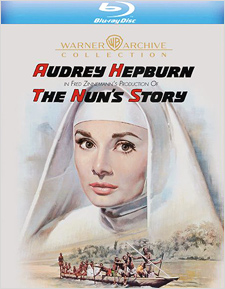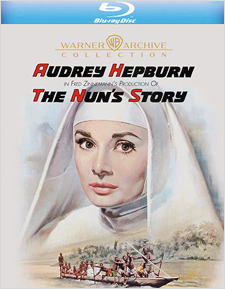Nun’s Story, The (Blu-ray Review)

Director
Fred ZinnemannRelease Date(s)
1959 (May 14, 2024)Studio(s)
Warner Bros. (Warner Archive Collection)- Film/Program Grade: A-
- Video Grade: A
- Audio Grade: A
- Extras Grade: C-
Review
The undervalued Fred Zinnemann (1907-1997) was a director of considerable taste, a rare commodity in Hollywood then and now. Never pandering, his films are noted for their excellent performances, attention to detail, sophistication, and deep humanism. His best works also have this quality of putting an intriguing and unusual spin on what, in other hands, could have resulted in a very conventional film. From Here to Eternity (1953), for instance, is like Joshua Logan’s Sayonara (1957), far darker and more critical of U.S. military life than just about any ‘50s Hollywood film, though censors held Zinnemann back some. Julia (1977) is a haunting historical drama with dream/nightmare-like qualities. Both pictures are immediately fully engrossing, and many of their most powerful scenes are tiny but intense little moments, like Lillian’s (Jane Fonda) fleeting meeting with the enigmatic Mr. Johann (Maximillian Schell) in Julia.
All of these qualities also manifest in The Nun’s Story (1959), one of Zinnemann’s best films, featuring one of Audrey Hepburn’s best performances, a personal favorite of the actress.
The film is an adaptation of Kathryn Hulme’s 1956 novel, a fictionalized account of the life of Belgian nurse and nun Marie Louise Habets. In late-1920s Belgium, Gabrielle “Gabby” Van Der Mal (Hepburn) leaves her family, including her beloved father (Dean Jagger), a noted physician, to enter the convent. Inheriting her father’s medical skills and highly educated, Gabrielle, now called Sister Luke, yearns to serve in the Belgian Congo, but her strong will proves as disadvantageous as it is an asset. She excels in her medical studies but unexpectedly is asked by the Reverend Mother to fail her medical exams on purpose—as a demonstration of the humility that she’s unable to find on her own.
She eventually earns an assignment in Africa as a nurse under atheist Dr. Fortunati (Peter Finch) but is further tested by additional hardships, including a nearly fatal battle with tuberculosis.
First and foremost, The Nun’s Story benefits from the methodical authenticity of its "behind closed doors" look into convent life and the European period flavor of Zinnemann’s impressively delicate direction of playwright Robert Anderson’s screenplay, and the frankly mesmerizing beauty of Audrey Hepburn, who was never more lovely than she is here, thanks partly to Franz Planer superb cinematography, one of the decade’s best. Zinnemann originally hoped to shoot all the scenes in Europe in black-and-white, with only the African scenes in full color, a fascinating concept, though the film does not suffer for its loss and, besides, Planer’s subdued use of color in the European scenes lend it an historical verisimilitude—it doesn’t have that travelogue-like quality so common to ‘50s Hollywood movies shot abroad. One does wish the film had been made at Paramount, where Hepburn was under contract, for it surely would have been filmed in VistaVision with its much higher resolution.
The film’s cast is peerless. Hepburn, herself born in Brussels and her own early life mirrors Sister Luke’s in many respects (both from upper class backgrounds, similar suffering during World War II, etc.); she obviously felt great affinity with the character. Besides Hepburn, Finch, and Jagger (also excellent), Zinnemann gets superb work from Edith Evans (as the sympathetic Mother Superior, Rev. Mother Emmanuel), Peggy Ashcroft (as Congo-based Mother Mathilde; her interactions with the indigenous people reminding one of her later A Passage to India), Mildred Dunnock (as Sister Margharita), Beatrice Straight (as Mother Christophe), and, in her screen debut, Colleen Dewhurst as “Archangel Gabriel,” a dangerous schizophrenic locked away in an asylum. Rosalie Crutchley, Lionel Jeffries, and Niall MacGinnis are also fine in small roles.
The Nun’s Story is steeped in ritual and history that, for Catholics and non-Catholics alike (Zinnemann was Jewish, Hepburn a Christian Scientist), is fascinating stuff. Cloistered life had never been dramatized in such detail before, and perhaps not since. The film is also one of the very few to successfully build itself around a conflict that is essentially internal and spiritual, and Hepburn and Zinnemann and Anderson pull it off remarkably well, with a main character whose obvious devotion and sacrifice alone cannot resolve fundamental conflicts of humility and obedience. The film was way ahead of its time in many respects, from its depiction of the mentally ill and leprosy victims (real ones are shown up-close), to a surprisingly enlightened attitude (by 1950s standards) of colonial Africa.
As with other Zinnemann films, it’s the little details that leave the strongest impressions. The standards of Catholic nuns, surrendering the Self to a life of poverty and obedience, is as all-consuming as the training of Japanese sumo rikishi, Olympic athletes, or the Marines undergoing basic training in Full Metal Jacket. Zinnemann masterfully conveys the great importance of the tiniest yet profound things—Gabrielle’s decision to keep a pen rather than part with this personal treasure, having a ring placed on her finger (and later removing it), symbolic of her “marriage” to Jesus Christ. We see Hepburn as Sister Luke carefully weigh every reaction to some other character’s remark in accordance to the strict rules of the order. What in many ways is most impressive about The Nun’s Story is that it’s that rarest of Hollywood movies—it’s a story about failure—spiritual failure at that—and, quite unlike other movies about nuns it’s not at all sentimental and its conclusion is ambiguous and open-ended.
Warner Archive’s The Nun’s Story is presented via a new 4K scan of the original camera negative. As noted above, one really wishes this were shot in VistaVision instead of regular 1.85:1 cropped widescreen, but the transfer squeezes out every detail possible and the subdued colors look just right. The DTS-HD Master Audio (2.0 mono) is also fine for what it is, getting the most out of Franz Waxman’s excellent musical score (one of his best) with optional English subtitles available. Disappointingly, the only extra feature is a so-so trailer.
Engrossing from beginning to end, impressing viewers in most every scene, The Nun’s Story is highly recommended.
- Stuart Galbraith IV

